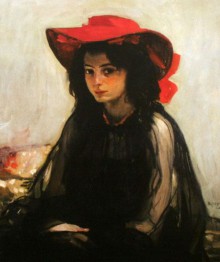Nature generously endowed Oleksandr Murashko with talent. Destiny gave him a short period of creative work, only 19 years. The artist’s oeuvre is versatile, uniting the elements of Realism, Expressionism, and Art Nouveau. He was fond of the nature of light reflexus, tried to master the most subtle modulation of the solar atmosphere. And at the same time he was moving towards the creation of a generalized image of psychological state of a human soul.
The artist was born on August 26, 1875 in Kyiv, but he was raised by his grandmother in the town of Borzna in Chernihiv oblast till he reached the age of seven. After his mother Maria Krachkovska married Oleksandr Murashko, he moved to Chernihiv, where his stepfather had a small icon-painting studio. His stepfather gave him his surname and involved in the work in the studio.
In the late 1880s Murashko’s studio received an order to accomplishing the artistic-decorating works in the newly-built St. Volodymyr Cathedral in the capital, which is why the family moved to Kyiv. That was how by will of destiny 15-year-old Oleksandr witnessed (and took part in) the decoration of the cathedral. He was lucky to witness the work of such noted painters as Viktor Vasnetsov and Mikhail Nesterov. Together with Prof. Adrian Prakhov, according to art expert Olha Zhbankova, “they were the first ones to pay attention to the aptitude of the thin, long-legged, and shy teenager with disheveled hair.” Painting became the sense of life of the young artist, and he even decided to become a professional painter. In this decision he was supported by his stepfather’s brother Mykola Murashko, the head of the Kyiv Painting Studio, where the young man attended classes after work.
In autumn 1894 Oleksandr Murashko entered the High Art School at the Petersburg Academy of Arts, and two years later became a student of Ilya Repin, one of the leading painters at that time and professor of the academy. At the turn of the century Murashko finished his studies, presenting for the examination competition the monumental painting Burial of Kish Otaman (1900). The topic of this work became a kind of (and well-aware) opposition to comic and somewhat grotesque painting by his teacher Reply of the Zaporozhian Cossacks to Sultan Mehmed IV of the Ottoman Empire. As Ph.D. in Art History Nazar Kozak aptly noted, “Oleksandr Murashko showed a different side of Cossacks, their knightly spirit and tragedy,” which ended by the defeat of the Zaporozhian Sich and imprisonment of Hetman Kalnyshevsky.
As a boarder of the Petersburg Academy of Art, the artist moved to Europe and discovered Paris, the then artistic capital of the world, and Munich, one of the most powerful art centers. During his stay there in 1901-03 the young artist came under influence of Impressionism and Art Nouveau. In his works Parisian Women, Near a Coffee-Shop, A Girl in a Red Hat Oleksandr Murashko seeks to create subtle nuances of tone transitions, showing the reflections of the artificial evening lights, which produces expressive light effects. Feeling that Paris was a wonderful place for general development, not for work, the artist moved to Munich, where he worked on improving of his drawing and familiarized himself with the works of the representatives of the Munich Secession.
In 1904 Oleksandr Murashko moved to Petersburg, to which he was more accustomed, trying to consolidate in practice his own painting positions, On a Skating-Rink, Winter. A Young Couple. And for the picture Merry-Go-Round (1906), which was on display at the 10th Munich International Exhibition in 1909, he was awarded with a Golden Medal. Since then the doors of art galleries of the most outstanding culture centers of Europe opened before the artist. His solo exhibits were held in Berlin, Dusseldorf, Cologne, and some canvasses were on display in Vienna, Paris, Amsterdam, Rome, and Venice. In 1911 Murashko was selected a member of the Munich Secession. When he came back to Kyiv, “where it was sunny, there was wonderful nature, and a culture of its own,” he bought a house in Lukianivka, planted a garden, built a studio, and invited his friends to settle nearby in the picturesque surroundings and dreamt of turning the Bahhovutivska Street in a kind of l’Ecole de Barbizon, a “town of artists.”
In 1913 Oleksandr Murashko founded his own art studio in the attic of one of the highest buildings of Kyiv, the 12-floor Ginzburg House in Instytutska Street. The studio’s studying process was organized according to the academic system – lectures on the history of art and philosophy interchanged with the drawing and painting classes.
In 1917 Ukraine became independent on the ruins of the Russian Empire. In the newly established Ukrainian Academy of Arts Oleksandr Murashko together with Heorhii Narbut, Vasyl and Fedir Krychevsky, Mykhailo Boichuk became one of its most active developers, a devoted teacher and social activist in the Art Council at the People’s Commissariat of Education. Having postponed creative work till the time when he, according to him, would pay his due to the social development and would be allowed to work peacefully. However, his plans never came out. On the night of June 14, 1919 a Bolshevik military patrol detained the artist near his house. In the morning of the following day he was found dead. The artist was shot in the back of his head, an execution way typical of the “Red revolutionaries,” who killed the nationally aware workers of Ukrainian science and culture.
Oleksandr Murashko is considered to be the first person on the list of artists and litterateurs of Ukraine’s Executed Renaissance of Ukraine in the 20th century.







